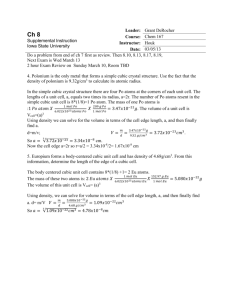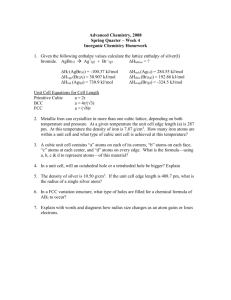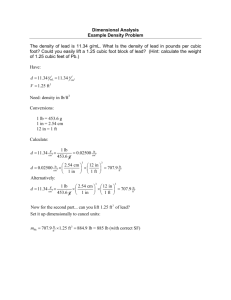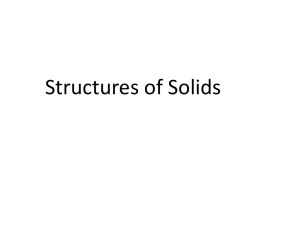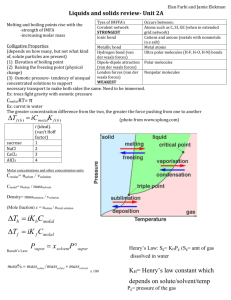HCCP Packing Diagram - Materials World Modules
advertisement
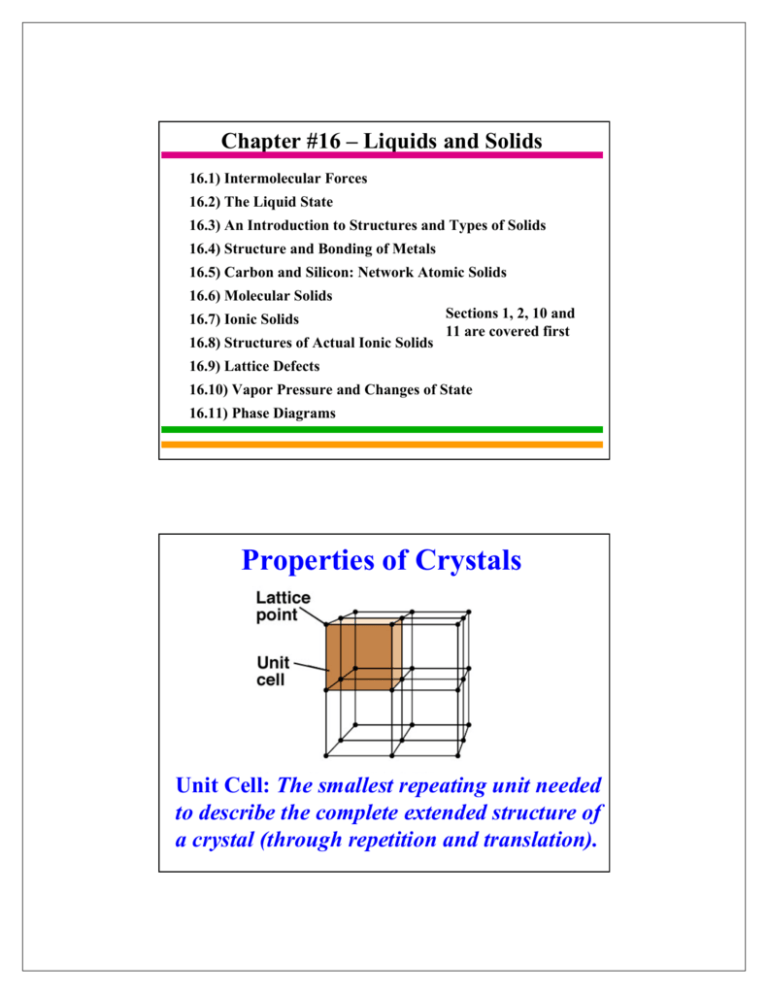
Chapter #16 – Liquids and Solids 16.1) Intermolecular Forces 16.2) The Liquid State 16.3) An Introduction to Structures and Types of Solids 16.4) Structure and Bonding of Metals 16.5) Carbon and Silicon: Network Atomic Solids 16.6) Molecular Solids 16.7) Ionic Solids 16.8) Structures of Actual Ionic Solids Sections 1, 2, 10 and 11 are covered first 16.9) Lattice Defects 16.10) Vapor Pressure and Changes of State 16.11) Phase Diagrams Properties of Crystals Unit Cell: The smallest repeating unit needed to describe the complete extended structure of a crystal (through repetition and translation). Some Common Crystal Lattices Figure 16.9 How do we know what crystals look like? x-ray diffraction Figure 16.10 Why x-rays? To satisfy the diffraction conditions, the wavelength of light needs to be comparable to the unit cell dimensions Ångstroms (10-10meters) Diffraction Conditions Figure 16.11 From Trigonometry: nl = 2d sinq 3 Types of Crystalline Solids Atomic Solids e.g. all metals, Si, Carbon (diamond, graphite) Ionic Solids e.g. salts like NaCl Molecular Solids e.g. protein crystals, sucrose Figure 16.12 Physical properties of crystals Crystal structure Physical Properties Bonding forces (intra- and inter-molecular) • melting point • mechanical strength • electrical properties Example: Copper and Diamond are both atomic solids, but they have very different physical properties: Copper: very soft, lower melting point (1083°C), excellent conductor Diamond: hardest known substance, higher m.p. (3500°C), insulator Structure and Bonding in Metals Zumdahl Section 16.4 Metals in solids can be treated as hard spheres that (usually) pack in a way to minimize the empty space between spheres. This is called closest packing. Two distinct structures can be formed by closest packing of atomsa cubic structure, and a hexagonal structure Cubic: x = y = z All unit cell angles = 90° Hexagonal: x = y " z some unit cell angles " 90° (60° or 120° instead) Cubic Closest Packed Structure Figure 16.13 Figure 16.15 Face Centered Cubic (fcc) How many atoms are in the fcc unit cell? Figure 16.17 6(atoms on faces) + 8(atoms on corners) = 6(1/2) + 8(1/8) =3+1 =4 Hexagonal Closest Packed Structure Figure 16.13 Figure 16.14 Hexagonal Prism (hcp) Both fcc and hcp have the same number of nearest neighbor interactions = 12 Figure 16.16 Packing Efficiency The fraction of the volume (often expressed as %) of the unit cell that is occupied by atoms, ions, or molecules PE = fv = volume of particles volume of unit cell Example: the face centered cubic unit cell PE = fv = = (#atoms in unit cell)(volume of atom) (side of cubic unit cell)3 (4)(4/3 pr3) a3 Example (cont): the face centered cubic unit cell a 4r a a a a2 + a2 = (4r)2 a=r8 So, (4)(4/3 pr3) = 0.74 or 74% a3 for the face centered cubic unit cell PE = fv = Body-centered cubic unit cell Simple cubic unit cell Figure 16.18 Figure 16.19 Figure 16.9 Cubic Crystal Lattices PE = 52% 6NN PE = 68% 8NN PE = 74% 12NN Determining Atomic Radius from a Crystal Structure Problem: Barium is the largest non-radioactive alkaline earth metal. It has a body-centered cubic unit cell and a density of 3.62g/cm3. What is the atomic radius of barium? (Volume of a sphere is V = 4/3 pr3.) Plan: Since an atom is spherical, we can find its radius from its volume. (1) From the density (mass/volume) and the molar mass (mass/mole), we find the molar volume of Ba metal. (2) Since it crystallizes in the body-centered cubic structure, 68% of this volume is occupied by Ba atoms, and the rest is empty. (3) Dividing by Avogadro’s number gives the volume of one Ba atom, from which we determine the atomic radius. Solution: 3 1 x M = 1 cm x 137.3 g Ba 3.62 g Ba 1 mol Ba density 3 = 37.9 cm /mol Ba Volume/mole of Ba metal = Volume/mole of Ba atoms = (volume/mol Ba) * (packing efficiency) = 37.9 cm3 / mol Ba * 0.68 = 26 cm3/mol Ba atoms Volume/Ba atom = 26 cm3 1 mol Ba atoms * 1 mol Ba atoms 6.022 x 1023 Ba atoms = 4.3 x 10 - 23 cm3/Ba atom Finding the atomic radius of Ba from the volume of a sphere: V of Ba atom = 4/3pr3 and r3 = r= 3 3V 4p = 3 3(4.3 x 10 - 23cm3) 4 x 3.14 3V 4p = 2.17 x 10 - 8 cm = 2.17Å The 14 possible Bravais Lattices: Combining 7 Crystal Classes (cubic, tetragonal, orthorhombic, hexagonal, monclinic, triclinic, trigonal) with 4 unit cell types (P, I, F, C), symmetry allows for only 14 types of 3-D lattice. Combining these 14 Bravais lattices with all possible symmetry elements (such as rotations, translations, mirrors, glides, etc.) yields 230 different Space Groups.
